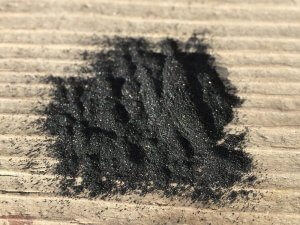If you’re an ethanol manufacturer and supplier, you’ve probably experienced a dramatic increase in demand for ethanol due to the recent Coronavirus pandemic and the FDA’s temporarily relaxed regulations for hand sanitizer production.
You’ve also probably received and endless string of complaints from hand sanitizer producers about the bad odors that can come from impure ethanol, an understandable complaint for a product consumers need to rub on their hands.
While you may think the only way to remove those odors from your USP Grade and FCC Grade ethanol is to invest in very costly carbon filtrations systems to further filter out the impurities of your ethanol, we’d ask that you think again… and consider our fragranced additive solutions, which successfully reduce these odors and leave ethanol-based hand sanitizers smelling fresh and clean.

Read on to explore how our cost-effective solutions reduce ethanol smells and how they can save you the time and money associated with investing in costly carbon filtration systems, or simply submit and inquiry or call to speak with our team today — +1-412-252-1012.
Hand Hygiene, Ethanol, Hand Sanitizers and COVID-19
As mentioned, ethanol manufacturers and suppliers are experiencing an unexpected boom in the demand for ethanol, as this substance has become the object of a new and different type of ‘gold rush.’ This is due to the fact that it is an essential ingredient used in hand sanitizers, the sales of which have gone through the roof since the onset of COVID-19.
Ethanol aka alcohol, ethyl alcohol and grain alcohol, is a clear, colorless liquid that dissolves easily in water and other organic amalgams, and is a prized ingredient in many product categories ranging from beauty and personal care to paints and varnishes to fuel.
In the dire absence of a vaccine or effective anti-viral drugs, hand hygiene has become the focus of efforts to prevent the spread of the virus that causes COVID-19. Washing hands thoroughly with soap and water for at least 20 seconds is considered a highly effective defense against harmful bacteria and viruses.

It is not, however, always a practical solution, especially for healthcare workers because of a lack of access to running water, and sufficient time to wash the hands thoroughly. This group, even more than others, is more likely to be exposed to infection from many sources every day.
Alcohol-based hand sanitizers provide a quick, simple alternative, and according to one study conducted by Professor Stephanie Pfänder, of the Department for Molecular and Medical Virology at Ruhr-Universität Bochum, in Germany, tests have confirmed that two hand sanitizer formulations recommended by the World Health Organization (WHO) have successfully deactivated the corona virus.
Study results give community and hospital pharmacies the green light to make their own sanitizers quickly and easily using the WHO formulations. They can be confident that store-bought hand sanitizing gels that contain at least 60% alcohol will be effective in combatting the deadly virus.

Ethanol is also the principle ingredient in alcoholic beverages like beer, wine or brandy. As such, like many other companies throughout this great nation, a large number of distillers have converted or expanded their production efforts to include the making of hand sanitizer as well.
Naturally, the recurring problem for distillers, brewers and other sanitizer producers is ethanol exudes a very unpleasant odor, which up to now only carbon filtration systems, which are very costly and take a great deal of time and effort to install, could effectively address what can only be called the “stink.” But there are other solutions.
Why Does Ethanol Smell So Badly?
As ethanol manufacturers are well aware, Ethyl alcohol (ethanol) has an offensive odor because of the way in which it is produced. Foul tasting chemicals (denaturants) such as: methanol; pyridine, isopropyl; alcohol; acetone; methyl ethyl ketone; methyl isobutyl ketone and denatonium combine to make it undrinkable.
The reason it is denatured is a deliberate move on the part of ethanol manufacturers to avoid the costly excise duty imposed on drinkable ethanol. In addition, ethanol’s offensive odor can also be, at least in part, the result of the fact that it is sourced from natural products. Its odors can range from a rotting garbage smell to tequila or an herbal spirit. For a product people use by rubbing it on their hands, this factor is understandably highly undesirable.
How Carbon Filtering Systems Work
Carbon filtering uses a bed of activated carbon to remove impurities from a fluid using adsorption, which refers to the adhesion of atoms, ions or molecules from a gas, liquid or dissolved solid to a surface. This process differs from absorption, in which a fluid is dissolved by or permeates a liquid or solid, respectively.
With granular activated carbon filtration, (GAC) activated carbon purifies liquids and gas. It is an ideal material because it has a high internal surface area and can be utilized in diverse applications, one of which is the removal of foul taste, odor, and hazardous chemicals.
Activated charcoal is carbon after it has been been treated with oxygen, which renders it highly porous. These tiny holes give the charcoal a surface area of 300-2,000 m2/g, allowing liquids or gases to pass through the charcoal and interact with the exposed carbon.

Since adsorption works by chemically binding the impurities to the carbon, the active sites in the charcoal eventually become filled. Activated charcoal filters lose their potency after extended use and must be either recharged or replaced. Timely cartridge replacement is very important, because there are diverse capacities for different contaminants.
Carbon attracts certain chemicals at the molecular level much in the same manner as a magnet attracts and holds metal items. These systems do effectively rid ethanol of most if not all of its impurities, but there are far less expensive and more timely options; namely, the ethanol odor reducing additives our chemists and master perfumers have produced.
Fragrance Design, Odor Control And Alpha Aromatics
Our team of researchers and fragrance developers at Alpha Aromatics are all experts in understanding the sub-conscious way humans approach and experience scent.
Our branding secret concerns the art and seemingly magical ability to transform a specific product so that it will appeal to a consumer seeking that product. This skill which really doesn’t even sound easy, is the culmination of decades of experience and innovative research, which are two areas where Alpha Aromatics excels and far exceeds all other companies of its ilk.
For ethanol manufacturers and suppliers, complaints from hand sanitizer producers about the bad odors associated with ethanol have propelled us to develop fragranced odor control solutions the reduce this smell and make these new hand sanitizers with their clear, uncomplicated, minty scent more palatable to a fearful population.

In the words of Bryan Zlotnik, COO of Alpha Aromatics, “After recently being approached by many manufacturers who sought our help in creating new and effective hand-sanitizer fragrances using ethanol due to the shortage of Isopropyl alcohol, we addressed the problem of bad odors and found several workable solutions. Our team developed a series of additives, which reduce the odors associated with ethanol, and yet at the same time, leaves the hand-sanitizer with a pleasant, clean scent when applied to the skin. We went even further and created a selection of fragrances to add to the solutions, keeping in mind not only personal preferences but also the fact that ethanol’s smell can vary and is dependent on its natural source.”
A Little More On Alpha Aromatics
Our perfume masters have been meeting the dynamic needs of consumers for more than seven decades. Family-run and in continuous operation since the aftermath of World War II, we are considered pioneers within the perfume industry.

Our continued success is no accident, as we continually invest heavily in the most innovative scientific tools, and the laboratories in our expansive 85,000-square-foot Pittsburgh Technology Center, which are equipped with state-of-the art innovations, such as: gas chromatography, mass spectrometry, head-space analysis, distillation, extraction and quality control technology.
Our technologies are and always have been sustainable, and they reflect a love and respect for planet Earth. The legacy we are leaving for our grandchildren has always been a major concern of ours, even long before it became fashionable and politically correct to think so.
We are also bound by the strict ethics, guidelines and quality standards set by The Research Institute for Fragrance Materials (RIFM), International Fragrance Association (IFRA), Oregon Tilth, International Sanitary Supply Association (ISSA) and the Natural Products Association (NPA) and the International Organization of Standardization (ISO).

In addition to fine fragrances, we also offer the world’s most efficient, innovative and effective options for odor-control additives. Today, we have undertaken the gargantuan task of harnessing all their skills to make ethanol use in hand sanitizers more palatable and pleasant smelling.
In Conclusion
Our fragranced odor neutralizing additive solutions are far less costly that carbon filtration systems and just as effective in filtering out the bad smells that come from ethanol production. Our innovative solutions, successfully reduce these odors and provide ethanol-based hand sanitizers with a pleasant minty scent.
If you’re ethanol producer and you want to avoid the high cost and time involved with installing carbon filtration systems to ethanol smells, send us a message or call our team today and see how we can help you and the hand sanitizer manufacturers you’re currently providing ethanol to — +1-412-252-1012.

A Brief Dive Into The Process Of Making Ethanol
Ethanol can be produced from any crop or plant that contains a large amount of sugar or components that can be converted into sugar, such as starch or cellulose. The method of production depends on the type of feedstock used. The process is shorter for starch-or sugar-based feedstocks than those that are are cellulose based. Creation differs depending on the prices utilized.
Over 90 percent of the grain ethanol produced today comes from the dry milling process, with the remaining coming from wet mills. The main difference between the two is in the initial treatment of the grain.
In the case of dry milling, the entire grain kernel is ground into “meal” and then forms a mash when slurred with water. Enzymes are added to the mash to convert starch to sugar. The mash is cooked, then cooled and transferred to fermenters.
In wet milling, the grain is first separated into its basic components via soaking.
Fermentation
With crops or plants, feedstock is ground up for easier processing, and through cooking, sugar is dissolved from the ground material. In the case of starch or cellulose, the compound is converted into sugar, which is a source of nourishment for microbes such as yeast or bacteria. Fermentation releases carbon dioxide as they feed on the sugar, producing ethanol and carbon dioxide as a byproduct.
The Wet Milling Process
Many large producers of ethanol utilize a wet-milling process, which separates the starch (corn) into several different components and affords many options for end products, including ethanol. This process involves a steeping period after which the grain germ, oil, starch, and gluten are all separated and further processed into many useful byproducts such as high-fructose corn syrup, which is used as a sweetener in many prepared foods. The corn is refined and sold as distiller’s grain, which is valuable as feed for livestock such as: cattle, hogs, and poultry.
Starch vs Cellulose
Sugars from beets and sugar cane must be extracted in order to be processed for ethanol production. The starch found in crops such as corn, wheat and barley make their conversion first to sugar and then to ethanol into a fairly simple process.
In the case of trees and grasses, much of their sugars are locked up in a fibrous material called cellulose, which is the most abundant bio-based material on earth. This compound can be broken down into sugars via fermentation by certain organisms and/or enzymes and then made into ethanol.
Currently, researchers are studying ways to make ethanol from cellulose’s sugar molecules that is extracted from biomass, such as corn cobs, corn stalks and leaves, straw from wheat or rice, perennial grasses and wood waste from the forestry and paper industries.
Call Alpha Aromatics today to avoid the high cost of carbon filtration systems through this newly explosive need for hand sanitizer era! +1-412-252-1012
Photo Credits: Pixabay
 alpha aromatics®
alpha aromatics®